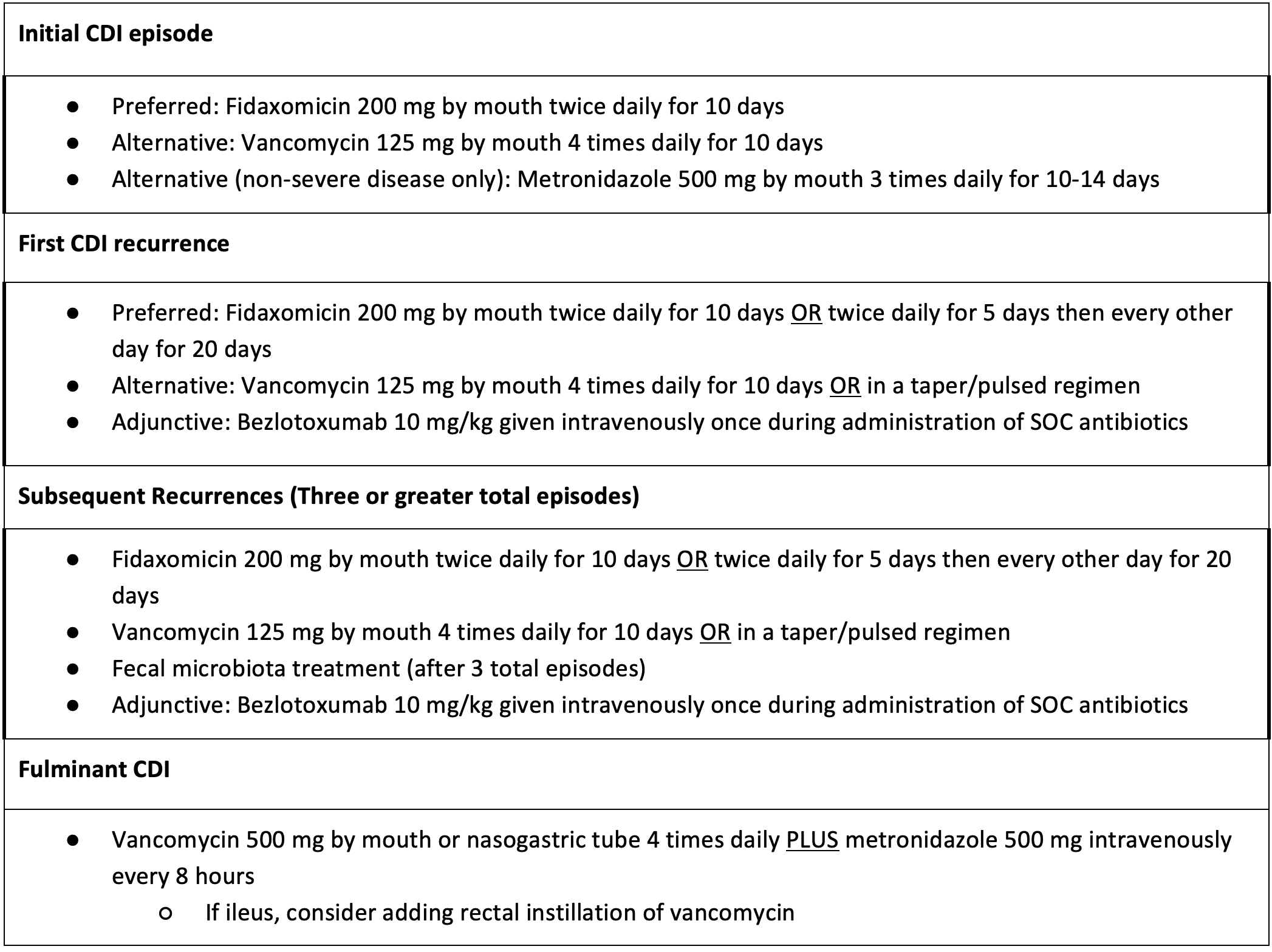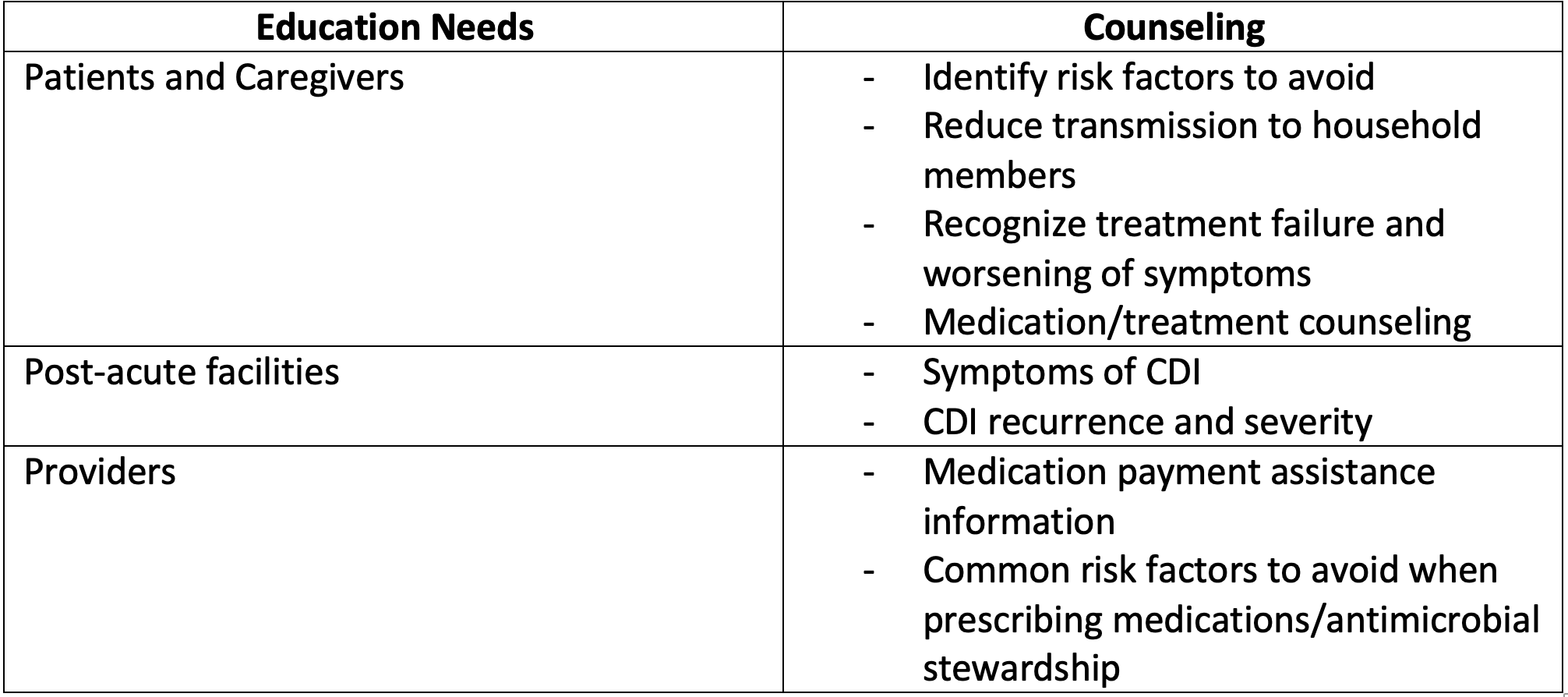Article
Management of Clostridoides Difficile: A Focus on the Pharmacist's Role in the Care Continuum
Author(s):
Patient education and counseling play a critical role in preventing C. difficile recurrence, and pharmacists are uniquely positioned to provide treatment recommendations, educate patients and health care providers, optimize transitions of care, and reduce the risk of recurrent CDI.
Background
Clostridioides difficile, a Gram-positive, spore-forming bacterium, can cause life-threatening infections that lead to colonic damage, diarrhea, and death. Typically transmitted by fecal-oral route, it can typically be found in air, water, human and animal feces, and in soil. Clostridioides difficile infection (CDI) is associated with numerous risk factors such as advanced age, proton pump inhibitors, and the use of antibiotics, which remains the most common factor.
Credit: luchschenF - stock.adobe.com.

Approximately 223,900 CDI cases occurred in hospitalized patients in 2019, leading to approximately 12,800 deaths.1 In total, an estimated 450,000 CDI cases occurred in the United States in 2011. Recurrence of CDI occurs in up to 25% of patients and increases to 40%-65% if the patient has already experienced a recurrence.2
Thus, health care professionals must have a proper understanding of the treatment options and strategies to prevent CDI recurrence. Patient education and counseling play a critical role in preventing recurrence, and pharmacists are uniquely positioned to provide treatment recommendations, educate both patients and health care providers, optimize transitions of care, and reduce the risk of recurrent CDI.
Treatment Considerations
Major developments in the management of CDI have been made in recent years. Standards of care and first-line therapies have changed with progress most significantly in the evolution of monoclonal antibodies and fecal microbiota transplantation (FMT) technology. New therapies for C. difficile, such as bezlotoxumab and oral fecal microbiota products, have changed the landscape of the disease state, especially regarding recurrence.
The Infectious Diseases Society of America (IDSA) and Society for Healthcare Epidemiology of America (SHEA) now recommend the use of fidaxomicin as the preferred option for an initial episode of CDI (Table 1).
In a pool analysis of 4 studies, fidaxomicin was more effective in increasing sustained response of CDI 4 weeks after therapy (RR: 1.16; 95% CI: 1.09–1.24) and demonstrated comparable initial clinical cure rates (RR: 1.00; 95% CI: 0.96–1.04). Additionally, there was not an increase in the incidence of drug-related adverse events (AEs) with fidaxomicin when compared to vancomycin (RR: 1.02; 95% CI: 0.76–1.36).3-6
Table 1. IDSA/SHEA Treatment Recommendations for Clostridioides difficile Infection in Adults7

Although the use of fidaxomicin has historically been cost prohibitive, a report from a tertiary academic medical center found that there has been improved formulary coverage of fidaxomicin after it was established as the preferred agent in the 2021 IDSA guideline recommendations. This study concluded that 93% of patients had a co-payment of ≤ $50.11
Another notable update in the management of CDI is the addition of bezlotoxumab for adjunctive treatment in recurrent infections. One study found that significantly lower recurrence rates were seen when used in conjunction with antibiotics.12
Although the trial did include small number of patients on fidaxomicin, bezlotoxumab has not been widely studied with the use of fidaxomicin and, therefore, the efficacy of their combined use should be interpreted cautiously. The direct patient cost of bezlotoxumab may be hard to predict, limiting ease of access and creating logistical issues with administration during standard of care antibiotics.
Educational Opportunities to Reduce CDI
With high rates of recurrence, it is important that health care providers utilize resources to reduce the risk of developing C. difficile. Several steps can be taken to help limit initial and recurring cases of CDI by placing an emphasis on infection control and access to treatment. As patients begin transitioning into different phases of their care, proper hygiene counseling and discussion of modifiable risk factors that can be avoided should be discussed.
Hand Hygiene
Patients’ hands have been shown to be contaminated with C.difficile at a rate of 32%, therefore, it is vital that patients and caretakers are counseled on the importance of proper hand hygiene and how it plays a role in the reduction of C. difficile transmission.8 When compared to alcohol-based hand sanitizers, cleansing the hands with soap and water is thought to be more effective, as the spores are resistant to being killed by alcohol.
Handwashing should occur after using the restroom, before eating, and any time hands are thought to be contaminated with C. difficile. For caretakers, proper handwashing and, when possible, gloves should be used when caring for patients with CDI.
Promoting Gut Health
Microbes in the intestinal tract influence metabolism and immunity. The gut is composed of more than 100 trillion bacteria and can provide resistance to pathogenic infections.14
Promoting a gut healthy lifestyle may include eating more fibers, drinking more water, and eating smaller, more frequent meals. Patients should also be counseled on eating a healthier diet after an episode of CDI because this may help restore the gut microbiome.
Although probiotics are thought to promote healthy bacteria in the gut, there is insufficient evidence to recommend its use for prevention of CDI. Saccharomyces boulardii and Lactobacillus species have shown promising results, however, neither have shown significant evidence of efficacy in clinical trials.8
Medication Stewardship
There are a few medication considerations and stewardship opportunities for pharmacists that may reduce the occurrence of CDI. Completing antibiotic treatment as prescribed is an important first step for patients with active CDI.
If the course is not completed, the patient is at a high risk for CDI recurrence. Additionally, limiting the use of unnecessary antibiotics can help prevent the development of C. difficile in all patients, as antibiotics can cause dysbiosis of the gut microbiome.
Ideally, the use of antibiotics should cover the offending organism with the narrowest bacterial coverage possible. Furthermore, a strong emphasis should be placed on duration of therapy.
The length of therapy can prolong gut dysbiosis, leading to increased risk of CDI. Increased antibiotic durations with broad bacterial coverage may cause irreparable damage to the gut microbiome and lead to recurrent CDI.16
Many meta-analyses have demonstrated significant CDI associations with antibiotics, with the highest risks seen in lincosamides, monobactams, penicillin combinations, carbapenems, and cephalosporins.10 Clindamycin carries the highest risk of C. difficile among all antibiotics.14
Pharmacists should make recommendations on using more targeted antibiotic therapy and evaluate judiciously for discontinuation. Utilizing a multidisciplinary approach will ensure multiple members of the health care team are evaluating antibiotic use and optimizing de-escalation efforts as soon as medically possible.
Proton pump inhibitors (PPIs) may also increase the risk of CDI by suppressing gastric acid. Although there are many conflicting reports about the increased risk of CDI with the use PPIs, it is prudent that medications are used appropriately for valid indications.15 In patients experiencing an initial episode or recurrence of CDI while on a PPI, pharmacists should screen and recommend stopping the unnecessary use of PPIs, when appropriate.
Medication Access
Pharmacists have an important role in advocating for patients obtaining appropriate and affordable medications regimens. Cost may play an important role in medication access for many patients.
The health care team should take this into consideration when recommending medications for discharge. Furthermore, pharmacists can leverage their role to identify patients who may significantly benefit from adjunct therapies and assess potential financial barriers that may delay treatment.
Pharmacists may also play a role in enhanced communication with a patient’s transition to their next phase of care. Post-acute facilities and/or caretakers should be instructed on proper medication regimens and instructions for treatment failure or noncompliance.
Conclusion
Pharmacists ultimately play a large role in the care continuum for CDI. Ensuring patients receive appropriate treatment and access to these therapies is fundamental to CDI care.
Patients will often begin treatment while in the hospital and need to continue treatment upon discharge. Pharmacists can recommend appropriate therapy, establish effective plans for transitions of care, and provide education that limits recurrence.
The medications utilized to treat CDI may pose financial barriers for patients. Pharmacists counseling patients being treated for CDI should also focus on the importance of appropriate medication administration, adherence, and proper hygiene.
Although antibiotics are the first-line treatment for CDI, they can exacerbate underlying dysbiosis and can heavily contribute to a cycle of recurrence.14 Pharmacists should also be aware of oral microbiome therapies in development and recognize their impact on the management of CDI.
Table 2: Pharmacist Counseling Opportunities

Overall, pharmacists are well positioned to contribute to the care continuum of patients with CDI. Moving forward, pharmacists’ efforts should aim to increase patient education, medication management, transition planning, provider engagement, and follow-up care when assisting in the treatment of CDI.13
Pharmacists should be keenly aware of developing therapies and updated standards of care as the management of CDI and pharmacy involvement continues to evolve.
References
- Paul Feuerstadt, Laura Stong, David N. Dahdal, Naomi Sacks, Kathleen Lang & Winnie W. Nelson (2020) Healthcare resource utilization and direct medical costs associated with index and recurrent Clostridioides difficile infection: a real-world data analysis, Journal of Medical Economics, 23:6, 603-609, DOI: 10.1080/13696998.2020.1724117
- “Your Risk of C. Diff.” Centers for Disease Control and Prevention, Centers for Disease Control and Prevention, 27 June 2022, https://www.cdc.gov/cdiff/risk.html.
- Louie TJ, Miller MA, Mullane KM, et al. Fidaxomicin versus vancomycin for Clostridium difficile infection. N Engl J Med. 2011;364(5):422-431. doi:10.1056/NEJMoa0910812
- CornelyOA, CrookDW, EspositoR, etal; OPT-80-004 Clinical Study Group. Fidaxomicin versus vancomycin for infection with Clostridium difficile in Europe, Canada, and the USA: a double-blind, non-inferiority, randomised controlled trial. Lancet Infect Dis 2012; 12:281–9.
- Guery B, Menichetti F, Anttila VJ, et al; EXTEND Clinical Study Group. Extended pulsed fidaxomicin versus vancomycin for Clostridium difficile infection in patients 60 years and older (EXTEND): a randomised, controlled, open-label, phase 3b/4 trial. Lancet Infect Dis 2018; 18:296–307.
- MikamoH, TatedaK, YanagiharaK, etal. Efficacy and safety of fidaxomicin for the treatment of Clostridioides (Clostridium) difficile infection in a randomized, double-blind, comparative phase III study in Japan. J Infect Chemother 2018; 24:744–52.
- Johnson S, Lavergne V, Skinner AM et al.Clinical practice guideline by the Infectious Diseases Society of America (IDSA) and Society for Healthcare Epidemiology of America (SHEA): 2021 focused update guidelines on management of Clostridioides difficile infection in adults. Clin Infect Dis 2021; 73: e1029–e44. https://doi.org/10.1093/cid/ciab549
- McDonald LC, Gerding DN, Johnson S et al.Clinical practice guidelines for Clostridium difficile infection in adults and children: 2017 update by the Infectious Diseases Society of America (IDSA) and Society for Healthcare Epidemiology of America (SHEA). Clin Infect Dis 2018; 66: 987–94. https://doi.org/10.1093/cid/ciy149
- Jiang Y, Sarpong EM, Sears P, Obi EN. Budget Impact Analysis of Fidaxomicin Versus Vancomycin for the Treatment of Clostridioides difficile Infection in the United States [published correction appears in Infect Dis Ther. 2022 Jan 16;:]. Infect Dis Ther. 2022;11(1):111-126. doi:10.1007/s40121-021-00480-0
- Teng C, Reveles KR, Obodozie-Ofoegbu OO, Frei CR. Clostridium difficile Infection Risk with Important Antibiotic Classes: An Analysis of the FDA Adverse Event Reporting System. Int J Med Sci. 2019;16(5):630-635. Published 2019 May 7. doi:10.7150/ijms.30739
- Fang N, Ha D, Dong K, et al. Successful Fidaxomicin Hospital Discharges of Adult Patients With Clostridioides difficile Infections Post-2021 Guidelines: Are Economic Barriers Finally Coming Down?. Clin Infect Dis. 2022;75(3):519-521. doi:10.1093/cid/ciab1061
- Wilcox MH, Gerding DN, Poxton IR, et al. Bezlotoxumab for Prevention of Recurrent Clostridium difficile Infection. N Engl J Med. 2017;376(4):305-317. doi:10.1056/NEJMoa1602615
- Khanna S, Lett J, Lattimer C, Tillotson G. Transitions of care in Clostridioides difficile infection: a need of the hour. Therap Adv Gastroenterol. 2022;15:17562848221078684. Published 2022 Feb 28. doi:10.1177/17562848221078684
- Langdon A, Crook N, Dantas G. The effects of antibiotics on the microbiome throughout development and alternative approaches for therapeutic modulation. Genome Med. 2016;8(1):39.
- Kelly CR, Fischer M, Allegretti JR, et al. ACG Clinical Guidelines: Prevention, Diagnosis, and Treatment of Clostridioides difficile Infections [published correction appears in Am J Gastroenterol. 2022 Feb 1;117(2):358]. Am J Gastroenterol. 2021;116(6):1124-1147. doi:10.14309/ajg.0000000000001278
- Ribeiro CFA, Silveira GGOS, Cândido ES, Cardoso MH, Espínola Carvalho CM, Franco OL. Effects of Antibiotic Treatment on Gut Microbiota and How to Overcome Its Negative Impacts on Human Health. ACS Infect Dis. 2020;6(10):2544-2559. doi:10.1021/acsinfecdis.0c00036






